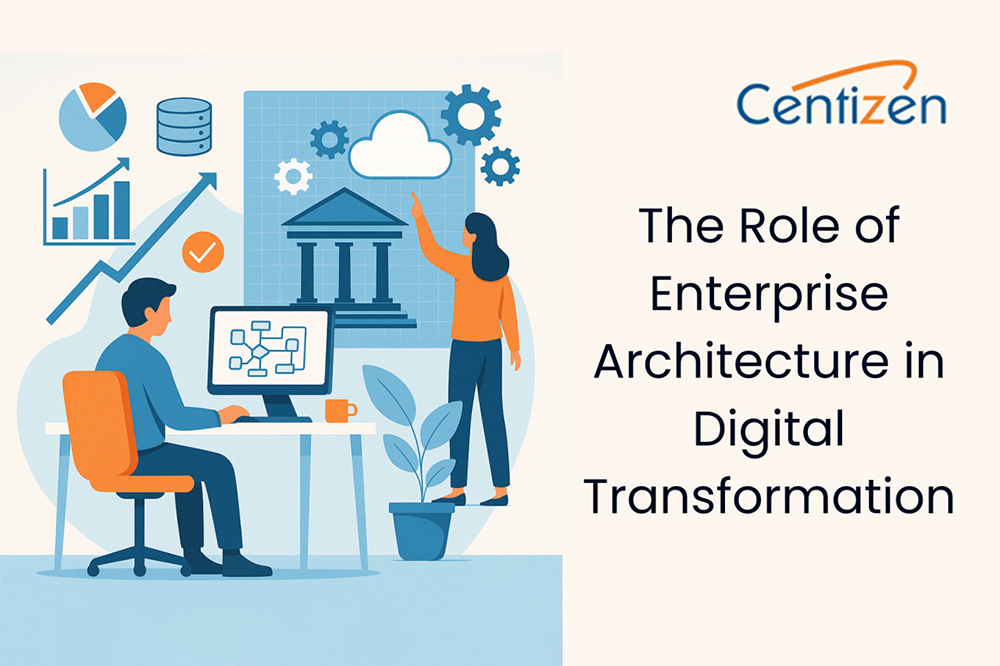The Role of Enterprise Architecture in Digital Transformation

In today’s fast-paced digital economy, organizations are under increasing pressure to modernize their IT infrastructure, adopt new technologies, and stay agile in the face of disruption. At the core of this transformation is enterprise architecture (EA) — a strategic framework that helps organizations align IT initiatives with business goals, drive innovation, and manage complexity.
Whether you’re leading a cloud migration, deploying AI tools, or streamlining business processes, enterprise architecture plays a vital role in enabling long-term success.
What is enterprise architecture?
Enterprise architecture is the discipline of planning, designing, and implementing cohesive IT strategies that support overall business objectives. It provides a holistic view of the organization’s technology landscape, including applications, systems, data, and processes.
Modern EA extends beyond IT to incorporate the entire business. It’s not just about technology infrastructure—it’s about enabling agility, reducing silos, and improving decision-making across all functions.
EA is especially critical during digital transformation, as it provides a blueprint for integrating new technologies while managing legacy systems and ensuring alignment with the organization’s strategic goals.
Key goals of enterprise architecture
Enterprise architecture is designed to help organizations:
- Align technology with business strategy
- Improve agility and adaptability
- Optimize legacy systems and processes
- Enable innovation and faster time to market
- Ensure governance, security, and compliance
- Support data-driven decision-making
A well-executed EA strategy helps organizations navigate technological change by providing a clear path forward—even during uncertainty or disruption.
Benefits of enterprise architecture in transformation initiatives
As businesses embrace cloud, AI, machine learning, and automation, EA ensures these initiatives are implemented in a way that delivers measurable outcomes. Key benefits include:
- Operational resilience: Enables organizations to withstand change and scale effectively.
- Improved customer experience: Integrates systems to support more consistent and responsive service.
- Cost efficiency: Eliminates redundancies and improves resource allocation.
- Faster innovation: Reduces complexity and accelerates digital projects.
- Standardization and governance: Brings discipline to IT systems and processes.
- Sustainability: Supports environmentally responsible IT practices in the age of energy-intensive AI.
In a Bizzdesign survey, organizations ranked sustainability, innovation, agility, and continuity among the top outcomes supported by enterprise architecture programs.
Leading enterprise architecture frameworks
There is no one-size-fits-all approach to EA. Instead, organizations adopt structured methodologies to guide implementation:
1. TOGAF (The open group architecture framework)
A globally recognized framework that offers a step-by-step approach to planning, designing, and managing enterprise IT.
2. Zachman framework
A taxonomy-based model that categorizes and organizes enterprise components using multiple viewpoints and stakeholders.
3. Federal enterprise architecture framework (FEAF)
Developed for U.S. federal agencies but widely adopted in the private sector for its emphasis on governance and effectiveness.
4. Gartner EA methodology
A practical, outcomes-based approach that emphasizes adaptability and business value rather than rigid processes.
Other niche-specific frameworks include MODAF (for defense), ESA-AF (for space agencies), and the SAP Enterprise Architecture Framework.
The enterprise architect’s role in digital transformation
Enterprise architects serve as the link between business goals and technology execution. Reporting typically to the CIO, they are responsible for:
- Designing scalable IT environments
- Leading cloud migration and modernization projects
- Aligning processes with business needs
- Advising on risk, compliance, and data governance
- Facilitating cross-functional communication
Skills required:
- Deep knowledge of IT systems and architecture
- Strategic planning and business analysis
- Expertise in cloud, security, and data integration
- Strong leadership, communication, and collaboration skills
According to PayScale, enterprise architects earn an average of $154,000 per year, with top salaries exceeding $220,000.
Enterprise architecture tools
While basic tools like Excel and PowerPoint are often used for visualizing EA, modern enterprises rely on specialized software for more complex needs.
Top EA tools (Gartner peer insights):
- LeanIX
- Orbus Software
- MEGA Hopex
- Horizzon
- Sparx Systems Enterprise Architect
These platforms integrate with project management, service management (ITSM), and configuration databases (CMDBs) to provide real-time insights and modeling capabilities.
Enterprise architecture certifications
Certifications validate your skills and help organizations trust your ability to lead complex transformation initiatives.
Popular certifications:
- TOGAF® 10 Certification
- Zachman Certified Enterprise Architect
- AWS or Azure Certified Architect
- ArchiMate Certification
- Certified Information Systems Architect (CISA)
Certifications are especially important for enterprise architects working in regulated or high-complexity industries.
Why enterprise architecture is critical to digital transformation
In a landscape shaped by rapid innovation, regulatory pressure, and evolving customer expectations, enterprise architecture acts as a compass. It ensures that transformation is not only possible—but also purposeful, scalable, and sustainable.
Whether you’re overhauling outdated systems, introducing AI-powered services, or integrating multiple platforms post-merger, EA provides the foundation for strategic, future-ready decision-making.
Our services:
- Staffing: Contract, contract-to-hire, direct hire, remote global hiring, SOW projects, and managed services.
- Remote hiring: Hire full-time IT professionals from our India-based talent network.
- Custom software development: Web/Mobile Development, UI/UX Design, QA & Automation, API Integration, DevOps, and Product Development.
Our products:
- ZenBasket: A customizable ecommerce platform.
- Zenyo payroll: Automated payroll processing for India.
- Zenyo workforce: Streamlined HR and productivity tools.
Services
Send Us Email
contact@centizen.com
Centizen
A Leading Staffing, Custom Software and SaaS Product Development company founded in 2003. We offer a wide range of scalable, innovative IT Staffing and Software Development Solutions.
Call Us
India: +91 63807-80156
USA & Canada: +1 (971) 420-1700
Send Us Email
contact@centizen.com
Centizen
A Leading Staffing, Custom Software and SaaS Product Development company founded in 2003. We offer a wide range of scalable, innovative IT Staffing and Software Development Solutions.
Call Us
India: +91 63807-80156
USA & Canada: +1 (971) 420-1700
Send Us Email
contact@centizen.com






